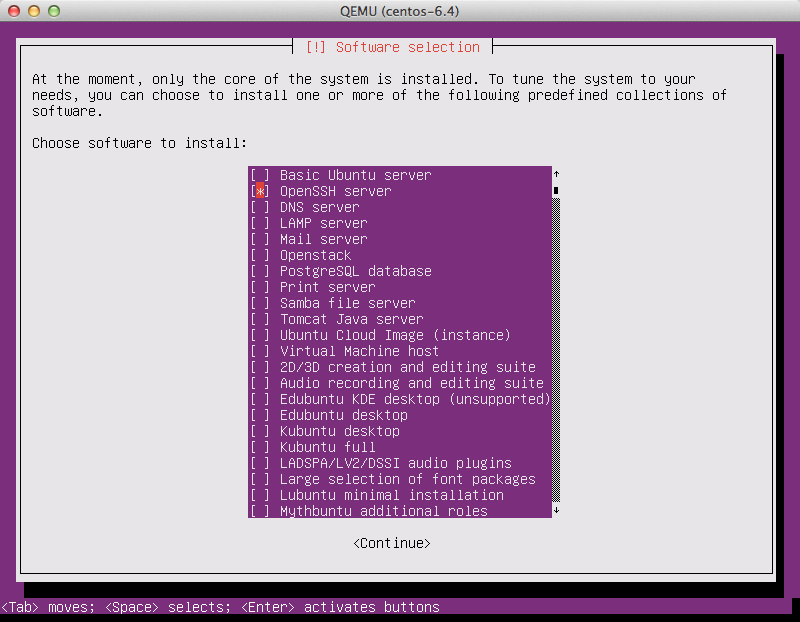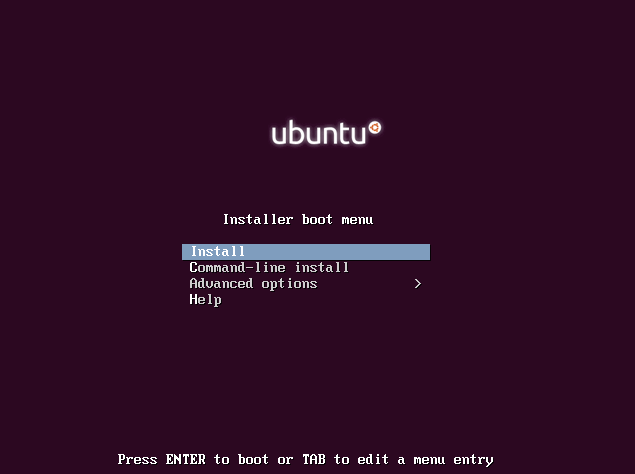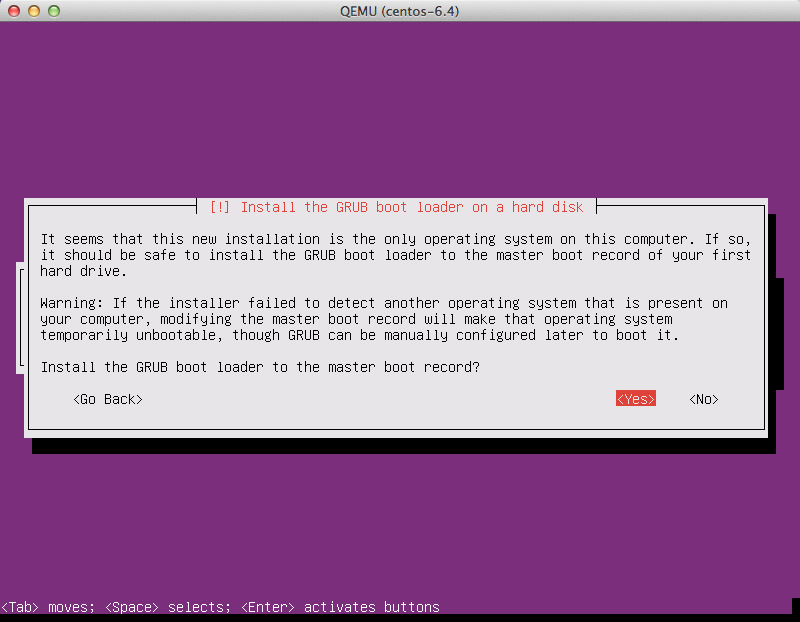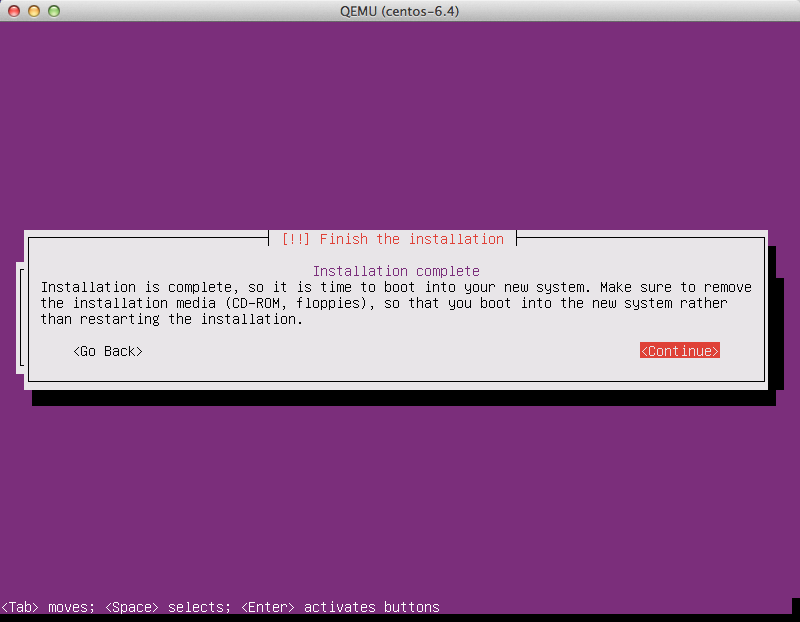Contents
- Example: Ubuntu image
- Download an Ubuntu installation ISO
- Start the installation process
- Step through the installation
- Hostname
- Select a mirror
- Step through the install
- Partition the disks
- Automatic updates
- Software selection: OpenSSH server
- Install GRUB boot loader
- Detach the CD-ROM and reboot
- Log in to newly created image
- Install cloud-init
- Shut down the instance
- Clean up (remove MAC address details)
- Undefine the libvirt domain
- Image is complete
Example: Ubuntu image¶
This example installs an Ubuntu 14.04 (Trusty Tahr) image. To create an image for a different version of Ubuntu, follow these steps with the noted differences.
Download an Ubuntu installation ISO¶
Because the goal is to make the smallest possible base image, this example uses the network installation ISO. The Ubuntu 64-bit 14.04 network installation ISO is at the Ubuntu download page.
Start the installation process¶
Start the installation process by using either virt-manager or virt-install as described in the previous section. If you use virt-install, do not forget to connect your VNC client to the virtual machine.
Assume that the name of your virtual machine image is ubuntu-14.04,
which you need to know when you use virsh commands
to manipulate the state of the image.
If you are using virt-manager, the commands should look something like this:
# qemu-img create -f qcow2 /tmp/trusty.qcow2 10G
# virt-install --virt-type kvm --name trusty --ram 1024 \
--cdrom=/data/isos/trusty-64-mini.iso \
--disk /tmp/trusty.qcow2,format=qcow2 \
--network network=default \
--graphics vnc,listen=0.0.0.0 --noautoconsole \
--os-type=linux --os-variant=ubuntutrusty
Step through the installation¶
At the initial Installer boot menu, choose the Install option. Step through the installation prompts, the defaults should be fine.
Hostname¶
The installer may ask you to choose a host name.
The default (ubuntu) is fine. We will install the cloud-init
package later, which will set the host name on boot when a new
instance is provisioned using this image.
Select a mirror¶
The default mirror proposed by the installer should be fine.
Step through the install¶
Step through the install, using the default options.
When prompted for a user name, the default (ubuntu) is fine.
Partition the disks¶
There are different options for partitioning the disks.
The default installation will use LVM partitions, and will create
three partitions (/boot, /, swap), and this will work fine.
Alternatively, you may wish to create a single ext4 partition,
mounted to “/”, should also work fine.
If unsure, we recommend you use the installer’s default partition scheme, since there is no clear advantage to one scheme or another.
Automatic updates¶
The Ubuntu installer will ask how you want to manage upgrades on your system. This option depends on your specific use case. If your virtual machine instances will be connected to the Internet, we recommend “Install security updates automatically”.
Software selection: OpenSSH server¶
Choose OpenSSH server so that you will be able to SSH into the virtual machine when it launches inside of an OpenStack cloud.

Install GRUB boot loader¶
Select Yes when asked about installing the GRUB boot loader to the master boot record.
For more information on configuring Grub, see the section called “Ensure image writes boot log to console”.
Detach the CD-ROM and reboot¶
Select the defaults for all of the remaining options. When the installation is complete, you will be prompted to remove the CD-ROM.
Note
There is a known bug in Ubuntu 14.04; when you select Continue,
the virtual machine will shut down, even though it says it will reboot.
To eject a disk using virsh, libvirt requires that
you attach an empty disk at the same target that the CDROM
was previously attached, which should be hdc.
You can confirm the appropriate target using the
virsh dumpxml vm-image command.
# virsh dumpxml trusty
<domain type='kvm'>
<name>trusty</name>
...
<disk type='block' device='cdrom'>
<driver name='qemu' type='raw'/>
<target dev='hdc' bus='ide'/>
<readonly/>
<address type='drive' controller='0' bus='1' target='0' unit='0'/>
</disk>
...
</domain>
Run the following commands in the host as root to start up
the machine again as paused, eject the disk and resume.
If you are using virt-manager, you may use the GUI instead.
# virsh start trusty --paused
# virsh attach-disk --type cdrom --mode readonly trusty "" hdc
# virsh resume trusty
Note
In the previous example, you paused the instance, ejected the disk, and unpaused the instance. In theory, you could have ejected the disk at the Installation complete screen. However, our testing indicates that the Ubuntu installer locks the drive so that it cannot be ejected at that point.
Log in to newly created image¶
When you boot for the first time after install, it may ask you about authentication tools, you can just choose Exit. Then, log in as root using the root password you specified.
Install cloud-init¶
The cloud-init script starts on instance boot and will search for a metadata provider to fetch a public key from. The public key will be placed in the default user account for the image.
Install the cloud-init package:
# apt-get install cloud-init
When building Ubuntu images cloud-init must be explicitly configured for the metadata source in use. The OpenStack metadata server emulates the EC2 metadata service used by images in Amazon EC2.
To set the metadata source to be used by the image run the
dpkg-reconfigure command against the cloud-init
package. When prompted select the EC2 data source:
# dpkg-reconfigure cloud-init
The account varies by distribution.
On Ubuntu-based virtual machines, the account is called ubuntu.
On Fedora-based virtual machines, the account is called ec2-user.
You can change the name of the account used by cloud-init
by editing the /etc/cloud/cloud.cfg file and adding a line
with a different user. For example, to configure cloud-init
to put the key in an account named admin, use the following
syntax in the configuration file:
users:
- name: admin
(...)
Clean up (remove MAC address details)¶
The operating system records the MAC address of the virtual Ethernet
card in locations such as /etc/udev/rules.d/70-persistent-net.rules
during the installation process. However, each time the image boots up,
the virtual Ethernet card will have a different MAC address,
so this information must be deleted from the configuration file.
There is a utility called virt-sysprep, that performs various cleanup tasks such as removing the MAC address references. It will clean up a virtual machine image in place:
# virt-sysprep -d trusty
Undefine the libvirt domain¶
Now that the image is ready to be uploaded to the Image service, you no longer need to have this virtual machine image managed by libvirt. Use the virsh undefine vm-image command to inform libvirt:
# virsh undefine trusty
Image is complete¶
The underlying image file that you created with the
qemu-img create command, such as /tmp/trusty.qcow2,
is now ready for uploading to the Image service by using the
openstack image create command. For more information, see the
Create or update an image.

Except where otherwise noted, this document is licensed under Creative Commons Attribution 3.0 License. See all OpenStack Legal Documents.


